Texas pool party: Would a police body camera have made a difference?
Loading...
Hundreds of people marched through the city of McKinney, Tex., Monday to protest the controversial crackdown by police officers on a group of teenagers accused of trespassing on a community pool.
The incident was captured in a video that shows McKinney officer Eric Casebolt, who is white, roughly handling a black teenage girl and pinning her to the ground. The video, which has since gone viral, has sparked outrage nationwide and added to already simmering tensions between local communities and police across the country.
It also again draws attention to the role of video in law enforcement, in particular to whether or not police officers should wear body cameras while on duty. Advocates have said that cameras promote transparency and accountability, while critics have noted that video, besides raising privacy issues, can be taken out of context and cause more harm than good.
“In theory, video sends a message of certainty: This is what happened and we can all see it,” journalists Marc Fisher and Peter Hermann wrote for The Washington Post. “Recorded snippets of an encounter between police and the public can reveal the crushing, life-or-death stress that officers face – and the overwhelming power an officer can wield.”
Body-camera advocates have pointed to studies that show improved behavior from police officers and suspects alike when they know they’re being recorded. Both social science and folk wisdom agree that in the presence of a recording device, people “tend to clean up their acts, steal less, act nicer,” Mr. Fisher and Mr. Hermann noted.
It’s a concept that some police departments are embracing in an effort to rebuild public trust following violent incidents between white officers and black men and boys: From Seattle to Los Angeles to Ferguson, Mo., patrolmen have started donning body cameras before going on duty.
Supporting these efforts is the Obama administration, which announced in May that it will provide $20 million in grants to help law enforcement agencies around the country buy body cameras and deploy the technology in their departments.
“Body-worn cameras hold tremendous promise for enhancing transparency, promoting accountability, and advancing public safety for law enforcement officers and the communities they serve,” Attorney-General Loretta Lynch said in announcing the grants.
The events in McKinney, however, raised a second point: A snippet of video doesn’t always tell the whole story.
Benet Embry, a longtime resident of Craig Ranch in McKinney, told CNN that the crowd of teenagers showed up at the community pool Friday, huddling by the gate, shouting be let in. Some climbed over the fence. This, Mr. Embry said, was against the rules, as the homeowners’ association allowed only two guests per resident.
A security guard, failing to get the teens to leave, called the police, Embry added. None of this was evident in the 7-minute video that a witness captured and uploaded online.
“Let me reiterate, the neighbors or the neighborhood did not call the police because this was an African-American party or whatever the situation is,” Embry, who is also black, told CNN. “This was not a racially motivated event – at all. This whole thing is being blown completely out of proportion.”
Does the addition of Embry’s narrative mean that Officer Casebolt, who has since been placed on administrative leave, should not be held accountable for what appeared to be an unnecessary use of force on an unarmed teenage girl? Probably not.
But it shows that the generalized use of video in law enforcement is something that needs to be considered carefully and well, Danah Boyd, founder of technology ethics think tank Data & Society, wrote for The Atlantic.
“The temptation of technology as an accountability tool is not new, but accountability is not done by technology. Accountability is achieved by people and systems using tools like technology as part of their bureaucratic processes,” noted Ms. Boyd, who co-wrote the op-ed with Data & Society researcher Alex Rosenblat.
“Who gets to see the footage, and in what circumstances, will matter,” they added.
In a January letter about modern policing policies, top officers of the Leadership Conference on Civil and Human Rights wrote:
Mobile video cameras are an increasingly ubiquitous tool with the potential to help protect civil rights and build trust between police and the communities they serve.
[But] department policy will play a critical role in determining whether and how video footage may be used to hold police accountable.… Without the right safeguards, there is a real risk that these new devices could become instruments of injustice.
One possible middle ground could lie in the use of video as a tool to help rookies and experienced officers learn from their mistakes and improve their performance.
“The recordings could be used as a valuable teaching tool in highlighting the many cases in which police officers acted well during the hundreds of different types of difficult situations,” The Christian Science Monitor’s Editorial Board wrote in an op-ed. “They would serve as models for how police can be the perfect professional.”






